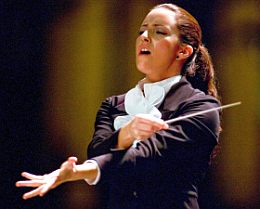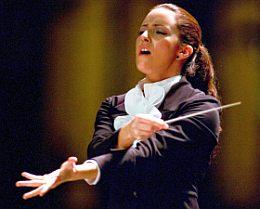
Last year, it was Dutch conductor Jaap van Zweden, making his Bay Area debut as music director of the Dallas Symphony. This season — Festival del Sole’s fourth — opened over the weekend with a round of concerts, receptions, “vintners’ luncheons,” and gala dinners. Of particular interest was the Bay Area debut of Mexican-American conductor Alondra de la Parra. (See an SFCV interview.)
Appearing Sunday at the Lincoln Theater in Yountville with her own Philharmonic Orchestra of the Americas, de la Parra led a program that featured Tchaikovsky’s Symphony No. 5 in E Minor. Mendelssohn’s Violin Concerto in E Minor, with Sarah Chang as soloist, and Mozart’s Overture to The Marriage of Figaro completed the program.
De la Parra, who holds the distinction of being the first woman from Mexico to conduct in New York City, has conducted the Houston Symphony and the Russian National Orchestra; upcoming dates with the New World Symphony, the Los Angeles Chamber Orchestra, and the Dallas Symphony are on her schedule. In November, the Manhattan-based conductor, who is still in her late 20s, will make her San Francisco Symphony debut.
She founded the Philharmonic Orchestra of the Americas (POA) in 2004 to promote the work of young American musicians and composers of North and South America; the ensemble comprises players mostly under the age of 35. The conductor has also presented more than 20 world premieres by such composers as Clarice Assad, Enrico Chapela, and Paul Desenne.
A Vivid Presence on the Podium
Sunday in Yountville, de la Parra bowed with traditional festival fare and made a strong first impression. Petite and graceful, the conductor is an energetic podium presence, and she elicited performances of assurance from her young musicians.The results were particularly arresting in the second half’s performance of Tchaikovsky’s Symphony No. 5. De la Parra set fleet, flexible tempos, eschewing flash in favor of warmth and nuance. Her musicians sounded alert and responsive throughout; in the first movement, the violins produced lush Romantic sound and the woodwinds gave distinctive voice to their wistful little figures.
The slow movement was just about ideal; the conductor again enforced a steady tempo, though she made a tender preparation for the expressive horn melody at the opening. De la Parra mined the third movement Valse for every drop of charm and character. And while the finale missed some of Tchaikovsky’s gripping momentum, it still came across with plenty of youthful exuberance.
If the performance wasn’t exemplary, it did recall the brilliant Bay Area debut of another young ensemble, Gustavo Dudamel and his Simón Bolívar Youth Orchestra. To be sure, this is another orchestra, with another conductor and its own distinctive sound. But the similarities — youthful vigor tied to a disciplined approach — are clear. If these ensembles represent the future for American orchestras, let’s have more of it.
Dabbing at the Surface
For many in the audience, Chang’s appearance in the Mendelssohn Violin Concerto was the program’s main event. The violinist has come a long way from her early days as a prodigy. Sunday, she made her entrance looking undeniably svelte and glamorous in a form-fitting, emerald-green gown. Yet, though her ostentatious style got the performance off to a fiery start, Chang never probed terribly deeply.The tone is harsh, the approach brusque to the point of heedlessness. Her playing in the opening Allegro was all on the surface, the cadenza more a product of muscle than nuance. Chang mustered lithe, lovely tone in the slow movement; in the finale, though, she left de la Parra and the orchestra in the dust. It wasn’t a disaster, but it won’t go down on record as one of the most sensitive performances of the Mendelssohn year.
No problems, however, in the program’s curtain-raiser, a splendid reading of Mozart’s Overture to The Marriage of Figaro. Vivacious and unified, it demonstrated the promise and potential of de la Parra and her orchestra to best advantage.
De la Parra and the POA return to the festival for two performances at Castello di Amorosa. On July 21, she conducts Vivaldi’s Four Seasons with violinist Chad Hoopes as soloist and film star Robert Redford as narrator. On July 22, the conductor leads Beethoven’s Symphony No. 2 and Brahms’ Violin Concerto, with Nikolaj Znaider as soloist. The festival concludes on July 25 with Antonio Pappano conducting the POA in Mozart’s Symphony No. 31; Leif Ove Andsnes is the soloist for Beethoven’s Piano Concerto No. 3, and Nina Kotova joins the orchestra in Haydn’s Cello Concerto in C Major. The program also includes Rossini’s Overture to The Barber of Seville.

